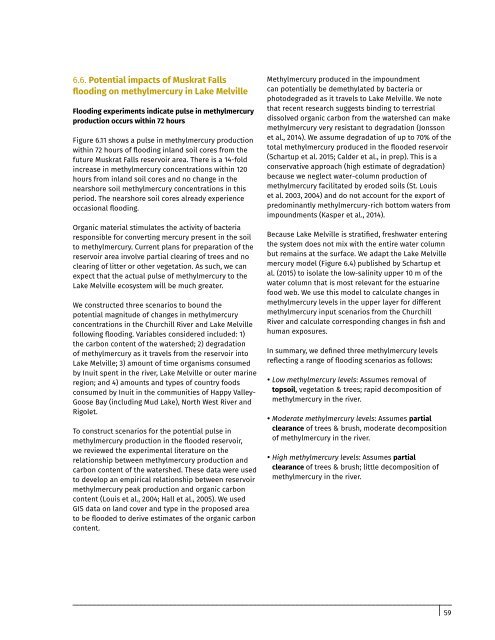Lake Melville
1rw7Mns
1rw7Mns
You also want an ePaper? Increase the reach of your titles
YUMPU automatically turns print PDFs into web optimized ePapers that Google loves.
6.6. Potential impacts of Muskrat Falls<br />
flooding on methylmercury in <strong>Lake</strong> <strong>Melville</strong><br />
Flooding experiments indicate pulse in methylmercury<br />
production occurs within 72 hours<br />
Figure 6.11 shows a pulse in methylmercury production<br />
within 72 hours of flooding inland soil cores from the<br />
future Muskrat Falls reservoir area. There is a 14-fold<br />
increase in methylmercury concentrations within 120<br />
hours from inland soil cores and no change in the<br />
nearshore soil methylmercury concentrations in this<br />
period. The nearshore soil cores already experience<br />
occasional flooding.<br />
Organic material stimulates the activity of bacteria<br />
responsible for converting mercury present in the soil<br />
to methylmercury. Current plans for preparation of the<br />
reservoir area involve partial clearing of trees and no<br />
clearing of litter or other vegetation. As such, we can<br />
expect that the actual pulse of methylmercury to the<br />
<strong>Lake</strong> <strong>Melville</strong> ecosystem will be much greater.<br />
We constructed three scenarios to bound the<br />
potential magnitude of changes in methylmercury<br />
concentrations in the Churchill River and <strong>Lake</strong> <strong>Melville</strong><br />
following flooding. Variables considered included: 1)<br />
the carbon content of the watershed; 2) degradation<br />
of methylmercury as it travels from the reservoir into<br />
<strong>Lake</strong> <strong>Melville</strong>; 3) amount of time organisms consumed<br />
by Inuit spent in the river, <strong>Lake</strong> <strong>Melville</strong> or outer marine<br />
region; and 4) amounts and types of country foods<br />
consumed by Inuit in the communities of Happy Valley-<br />
Goose Bay (including Mud <strong>Lake</strong>), North West River and<br />
Rigolet.<br />
To construct scenarios for the potential pulse in<br />
methylmercury production in the flooded reservoir,<br />
we reviewed the experimental literature on the<br />
relationship between methylmercury production and<br />
carbon content of the watershed. These data were used<br />
to develop an empirical relationship between reservoir<br />
methylmercury peak production and organic carbon<br />
content (Louis et al., 2004; Hall et al., 2005). We used<br />
GIS data on land cover and type in the proposed area<br />
to be flooded to derive estimates of the organic carbon<br />
content.<br />
Methylmercury produced in the impoundment<br />
can potentially be demethylated by bacteria or<br />
photodegraded as it travels to <strong>Lake</strong> <strong>Melville</strong>. We note<br />
that recent research suggests binding to terrestrial<br />
dissolved organic carbon from the watershed can make<br />
methylmercury very resistant to degradation (Jonsson<br />
et al., 2014). We assume degradation of up to 70% of the<br />
total methylmercury produced in the flooded reservoir<br />
(Schartup et al. 2015; Calder et al., in prep). This is a<br />
conservative approach (high estimate of degradation)<br />
because we neglect water-column production of<br />
methylmercury facilitated by eroded soils (St. Louis<br />
et al. 2003, 2004) and do not account for the export of<br />
predominantly methylmercury-rich bottom waters from<br />
impoundments (Kasper et al., 2014).<br />
Because <strong>Lake</strong> <strong>Melville</strong> is stratified, freshwater entering<br />
the system does not mix with the entire water column<br />
but remains at the surface. We adapt the <strong>Lake</strong> <strong>Melville</strong><br />
mercury model (Figure 6.4) published by Schartup et<br />
al. (2015) to isolate the low-salinity upper 10 m of the<br />
water column that is most relevant for the estuarine<br />
food web. We use this model to calculate changes in<br />
methylmercury levels in the upper layer for different<br />
methylmercury input scenarios from the Churchill<br />
River and calculate corresponding changes in fish and<br />
human exposures.<br />
In summary, we defined three methylmercury levels<br />
reflecting a range of flooding scenarios as follows:<br />
• Low methylmercury levels: Assumes removal of<br />
topsoil, vegetation & trees; rapid decomposition of<br />
methylmercury in the river.<br />
• Moderate methylmercury levels: Assumes partial<br />
clearance of trees & brush, moderate decomposition<br />
of methylmercury in the river.<br />
• High methylmercury levels: Assumes partial<br />
clearance of trees & brush; little decomposition of<br />
methylmercury in the river.<br />
59


